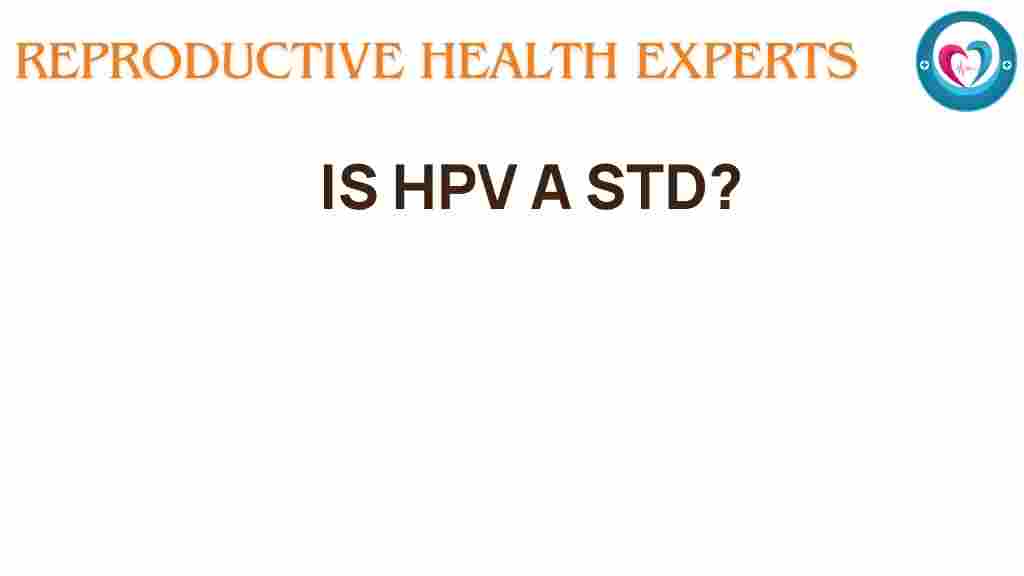Unraveling the Mystery: Is HPV Really an STD?
Human Papillomavirus (HPV) is a term that often evokes confusion and concern. Many people wonder whether HPV is truly a sexually transmitted disease (STD), what health risks are associated with it, and how they can prevent it. This article will delve into these questions, debunk myths, and highlight the importance of awareness, education, and vaccination in combating HPV.
Understanding HPV: The Basics
HPV is a group of more than 200 related viruses, some of which can lead to serious health issues. While HPV is primarily known as a sexually transmitted disease, it’s crucial to understand its various strains and how they can affect individuals differently.
- Low-risk HPV: These strains can cause warts, including genital warts, but are not associated with cancer.
- High-risk HPV: Certain strains can lead to cancers, such as cervical, anal, and oropharyngeal cancers.
How is HPV Transmitted?
HPV is predominantly transmitted through intimate skin-to-skin contact. This includes:
- Vaginal and anal intercourse
- Oral sex
- Genital contact without penetration
It’s important to note that HPV can be transmitted even when an infected person has no visible signs or symptoms. This silent nature of HPV is one of the reasons why it is so widespread.
Health Risks Associated with HPV
While many HPV infections resolve on their own without causing health problems, some can lead to serious health risks. Understanding these risks is vital for awareness and prevention.
- Cervical Cancer: High-risk HPV types are the primary cause of cervical cancer, making regular screenings essential.
- Other Cancers: HPV is linked to several other cancers, including vulvar, vaginal, anal, and head and neck cancers.
- Genital Warts: Low-risk HPV can cause genital warts, which, while not life-threatening, can be uncomfortable and distressing.
Myths Surrounding HPV
Misunderstandings about HPV can foster stigma and prevent individuals from seeking necessary health care. Here are some common myths debunked:
- Myth 1: HPV is only a concern for women.
- Myth 2: You can only get HPV if you have multiple sexual partners.
- Myth 3: HPV is always symptomatic.
Educating yourself and others about HPV can combat these myths and promote a healthier dialogue around sexual health.
Prevention: Steps to Reduce the Risk of HPV
While there is no cure for HPV, several strategies can significantly reduce the risk of infection:
- Vaccination: The HPV vaccine is highly effective in preventing infections from the most dangerous strains. It is recommended for preteens, but can be given up to age 45.
- Regular Screenings: Women should have regular Pap tests to detect any changes in cervical cells early.
- Safe Sex Practices: Using condoms can reduce the risk of transmitting HPV, although they do not eliminate it entirely.
The Role of Education and Awareness
Increasing awareness about HPV and its transmission is crucial in combating this common virus. Educational initiatives can empower individuals to take control of their sexual health.
- Schools: Incorporating comprehensive sexual education into school curricula can inform young people about HPV and safe sexual practices.
- Healthcare Providers: Providers should discuss HPV with patients during routine check-ups and recommend vaccinations and screenings.
- Community Programs: Local health departments can hold workshops and distribute materials to educate the public about HPV.
Vaccines: A Powerful Tool Against HPV
The introduction of HPV vaccines has been a game-changer in the fight against this sexually transmitted disease. Here’s what you need to know:
- Types of Vaccines: There are several vaccines available, such as Gardasil and Cervarix, that target the most common and high-risk HPV strains.
- Who Should Get Vaccinated? Vaccination is recommended for preteens aged 11 to 12, but catch-up vaccinations are available for individuals up to 26 years old, and some adults aged 27 to 45 may benefit as well.
- Effectiveness: Studies show that HPV vaccines significantly reduce the incidence of cervical cancer and genital warts.
Step-by-Step Process for HPV Awareness and Prevention
Here’s a step-by-step guide to help you and others stay informed about HPV:
- Get Educated: Learn about HPV, its risks, and prevention methods.
- Discuss with Your Partner: Have open conversations about sexual health and HPV testing.
- Consult a Healthcare Provider: Ask about vaccination and screenings.
- Practice Safe Sex: Use condoms and limit the number of sexual partners.
- Stay Informed: Follow the latest research and recommendations regarding HPV.
Troubleshooting Tips: What to Do if You’re Concerned About HPV
If you have concerns about HPV, here are some troubleshooting tips:
- Seek Medical Advice: If you notice unusual symptoms, such as warts or changes in your genital area, consult your healthcare provider.
- Get Tested: Discuss HPV testing options with your doctor, especially if you are at risk.
- Stay Updated: Regularly check for updates on HPV treatments, vaccines, and screening recommendations.
Conclusion: The Path Forward in HPV Awareness
In conclusion, understanding HPV as a sexually transmitted disease is crucial for reducing its impact on public health. Awareness, education, and prevention through vaccination and safe practices are vital steps in combating the health risks associated with HPV. By breaking down myths and fostering open discussions about sexual health, we can empower individuals and communities to take proactive measures.
For more information on HPV and related health topics, consider visiting CDC’s HPV page or checking resources from your local health department. Remember, knowledge is power—stay informed, stay safe!
This article is in the category Conditions and created by ReproductiveHealthExperts Team
